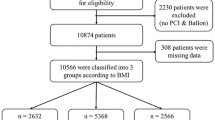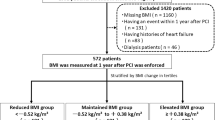Abstract
Obesity is an important public health problem, especially among patients with cardiovascular disease. However, little is known about the impact of obesity on the long-term prognoses of patients with acute myocardial infarction (AMI). Major adverse cardiac and cerebrovascular events (MACCE) consist of all causes of death, stroke, target lesion revascularization, target vessel revascularization, non-fatal myocardial infarction, and hospitalization. From January 2001 to March 2005, we analyzed 121 patients who survived >30 days after suffering their first AMI of the left anterior descending artery for MACCE. The mean follow-up period for this study was 59 ± 26 months. Seventy-five patients presented with normal weight (BMI <25 kg/m2) and 46 were obese (BMI >25 kg/m2). During the follow-up period, 56 patients presented MACCE, including 18 deaths, 11 strokes, and seven non-fatal myocardial infarctions. Normal weight was significantly associated with the occurrence of MACCE (p = 0.012). Grouping of the patients by BMI and homeostasis model assessment ratio (HOMA-R) indicated that the combination of a higher BMI (>25) and lower insulin resistance (HOMA-R < 2.0) provided the best prognosis (p = 0.0006). Kaplan–Meier curves stratified to the four groups, sorted by diabetes mellitus and BMI at admission, showed that the normal weight patients with diabetes mellitus presented the highest risk of MACCE (p < 0.0001). Patients with higher BMI and no insulin resistance or diabetes mellitus present better long-term outcomes following anterior AMI.



Similar content being viewed by others
References
Calle E, Thun M, Petrelli J, Rodriguez C, Heath CJ (1999) Body-mass index and mortality in a prospective cohort of US adults. N Engl J Med 341:1097–1105
Wilson P, D’Agostino R, Sullivan L, Parise H, Kannel W (2002) Overweight and obesity as determinants of cardiovascular risk: the Framingham experience. Arch Intern Med 162:1867–1872
Manson J, Willett W, Stampfer M, Colditz G, Hunter D, Hankinson S, Hennekens C, Speizer F (1995) Body weight and mortality among women. N Engl J Med 333:677–685
Stevens J, Cai J, Pamuk E, Williamson D, Thun M, Wood J (1998) The effect of age on the association between body mass index and mortality. N Engl J Med 338:1–7
Rosengren A, Wedel H, Wilhelmsen L (1999) Body weight and weight gain during adult life in men in relation to coronary heart disease and mortality. A prospective population study. Eur Heart J 20:269–277
Garrison R, Castelli W (1985) Weight and thirty-year mortality of men in the Framingham Study. Ann Intern Med 103:1006–1009
Walker M, Wannamethee G, Whincup P, Shaper A (1995) Weight change and risk of heart attack in middle-aged British men. Int J Epidemiol 24:694–703
Rabkin S, Mathewson F, Hsu P (1977) Relation of body weight to development of ischemic heart disease in a cohort of young North American men after a 26-year observation period: the Manitoba Study. Am J Cardiol 39:452–458
Gruberg L, Weissman N, Waksman R, Fuchs S, Deible R, Pinnow E, Ahmed L, Kent K, Pichard A, Suddath W, Satler L, Lindsay JJ (2002) The impact of obesity on the short-term and long-term outcomes after percutaneous coronary intervention: the obesity paradox? J Am Coll Cardiol 39:578–584
Gurm H, Brennan D, Booth J, Tcheng J, Lincoff A, Topol E (2002) Impact of body mass index on outcome after percutaneous coronary intervention (the obesity paradox). Am J Cardiol 90:42–45
Powell B, Lennon R, Lerman A, Bell M, Berger P, Higano S, Holmes DJ, Rihal C (2003) Association of body mass index with outcome after percutaneous coronary intervention. Am J Cardiol 91:472–476
Minutello R, Chou E, Hong M, Bergman G, Parikh M, Iacovone F, Wong S (2004) Impact of body mass index on in-hospital outcomes following percutaneous coronary intervention (report from the New York State Angioplasty Registry). Am J Cardiol 93:1229–1232
Mehta L, Devlin W, McCullough P, O’Neill W, Skelding K, Stone G, Boura J, Grines C (2007) Impact of body mass index on outcomes after percutaneous coronary intervention in patients with acute myocardial infarction. Am J Cardiol 99:906–910
Nikolsky E, Stone G, Grines C, Cox D, Garcia E, Tcheng J, Griffin J, Guagliumi G, Stuckey T, Turco M, Negoita M, Lansky A, Mehran R (2006) Impact of body mass index on outcomes after primary angioplasty in acute myocardial infarction. Am Heart J 151:168–175
Lee J, Park H, Chae S, Cho Y, Yang D, Jeong M, Kim Y, Kim K, Hur S, Seong I, Hong T, Cho M, Kim C, Jun J, Park W (2009) Predictors of six-month major adverse cardiac events in 30-day survivors after acute myocardial infarction (from the Korea Acute Myocardial Infarction Registry). Am J Cardiol 104:182–189
Nigam A, Wright R, Allison T, Williams B, Kopecky S, Reeder G, Murphy J, Jaffe A (2006) Excess weight at time of presentation of myocardial infarction is associated with lower initial mortality risks but higher long-term risks including recurrent re-infarction and cardiac death. Int J Cardiol 110:153–159
Wang J, Thornton J, Burastero S, Shen J, Tanenbaum S, Heymsfield S, Pierson RJ (1996) Comparisons for body mass index and body fat percent among Puerto Ricans, blacks, whites and Asians living in the New York City area. Obes Res 4:377–384
Tunstall-Pedoe H, Kuulasmaa K, Amouyel P, Arveiler D, Rajakangas A, Pajak A (1994) Myocardial infarction and coronary deaths in the World Health Organization MONICA Project. Registration procedures, event rates, and case-fatality rates in 38 populations from 21 countries in four continents. Circulation 90:583–612
Lee K, Woodlief L, Topol E, Weaver W, Betriu A, Col J, Simoons M, Aylward P, Van de Werf F, Califf R (1995) Predictors of 30-day mortality in the era of reperfusion for acute myocardial infarction. Results from an international trial of 41,021 patients. GUSTO-I Investigators. Circulation 91:1659–1668
Gurm HS, Whitlow PL, Kip KE, BARI Investigators (2002) The impact of body mass index in short- and long-term outcomes in patients undergoing coronary revascularization. Insights from the Bypass Angioplasty Revascularization Investigation (BARI). J Am Coll Cardiol 39:834–840
Ndrepepa G, Keta D, Byrne RA, Schulz S, Mehilli J, Seyfarth M, Schömig A, Kastrati A (2010) Impact of body mass index on clinical outcomes in patients with acute coronary syndromes treated with percutaneous coronary intervention. Heart Vessels 25:27–34
Sakakura K, Kubo N, Ako J, Ikeda N, Funayama H, Hirahara T, Wada H, Sugawara Y, Yasu T, Kawakami M, Momomura S (2009) Clinical features of early recurrent myocardial infarction. Heart Vessels 24:347–351
Ikeda N, Nakajima R, Tsunoda T, Nakamura M, Sugi K (2007) Insulin resistance and acute coronary syndrome in the young Japanese population have a strong association. Heart Vessels 22:165–169
Cui R, Iso H, Toyoshima H, Date C, Yamamoto A, Kikuchi S, Kondo T, Watanabe Y, Koizumi A, Wada Y, Inaba Y, Tamakoshi A (2005) Body mass index and mortality from cardiovascular disease among Japanese men and women: the JACC study. Stroke 36:1377–1382
Vasseur F, Helbecque N, Lobbens S, Vasseur-Delannoy V, Dina C, Clément K, Boutin P, Kadowaki T, Scherer P, Froguel P (2005) Hypoadiponectinaemia and high risk of type 2 diabetes are associated with adiponectin-encoding (ACDC) gene promoter variants in morbid obesity: evidence for a role of ACDC in diabesity. Diabetologia 48:892–899
Oike Y, Akao M, Yasunaga K, Yamauchi T, Morisada T, Ito Y, Urano T, Kimura Y, Kubota Y, Maekawa H, Miyamoto T, Miyata K, Matsumoto S, Sakai J, Nakagata N, Takeya M, Koseki H, Ogawa Y, Kadowaki T, Suda T (2005) Angiopoietin-related growth factor antagonizes obesity and insulin resistance. Nat Med 11:400–408
Mori Y, Kim-Motoyama H, Katakura T, Yasuda K, Kadowaki H, Beamer B, Shuldiner A, Akanuma Y, Yazaki Y, Kadowaki T (1998) Effect of the Pro12Ala variant of the human peroxisome proliferator-activated receptor gamma 2 gene on adiposity, fat distribution, and insulin sensitivity in Japanese men. Biochem Biophys Res Commun 251:195–198
Miyamatsu N, Kadowaki T, Okamura T, Hayakawa T, Kita Y, Okayama A, Nakamura Y, Oki I, Ueshima H (2005) Different effects of blood pressure on mortality from stroke subtypes depending on BMI levels: a 19-year cohort study in the Japanese general population–NIPPON DATA80. J Hum Hypertens 19:285–291
Kim-Motoyama H, Yasuda K, Yamaguchi T, Yamada N, Katakura T, Shuldiner A, Akanuma Y, Ohashi Y, Yazaki Y, Kadowaki T (1997) A mutation of the beta 3-adrenergic receptor is associated with visceral obesity but decreased serum triglyceride. Diabetologia 40:469–472
Author information
Authors and Affiliations
Corresponding author
Rights and permissions
About this article
Cite this article
Ikeda, N., Nakajima, R., Utsunomiya, M. et al. Higher body mass index at the time of acute myocardial infarction is associated with a favorable long-term prognosis (8-year follow-up). Heart Vessels 26, 495–501 (2011). https://doi.org/10.1007/s00380-010-0083-3
Received:
Accepted:
Published:
Issue Date:
DOI: https://doi.org/10.1007/s00380-010-0083-3




